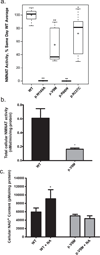NMNAT1 mutations cause Leber congenital amaurosis
- PMID: 22842227
- PMCID: PMC3454532
- DOI: 10.1038/ng.2361
NMNAT1 mutations cause Leber congenital amaurosis
Abstract
Leber congenital amaurosis (LCA) is an infantile-onset form of inherited retinal degeneration characterized by severe vision loss(1,2). Two-thirds of LCA cases are caused by mutations in 17 known disease-associated genes(3) (Retinal Information Network (RetNet)). Using exome sequencing we identified a homozygous missense mutation (c.25G>A, p.Val9Met) in NMNAT1 that is likely to be disease causing in two siblings of a consanguineous Pakistani kindred affected by LCA. This mutation segregated with disease in the kindred, including in three other children with LCA. NMNAT1 resides in the previously identified LCA9 locus and encodes the nuclear isoform of nicotinamide mononucleotide adenylyltransferase, a rate-limiting enzyme in nicotinamide adenine dinucleotide (NAD(+)) biosynthesis(4,5). Functional studies showed that the p.Val9Met alteration decreased NMNAT1 enzyme activity. Sequencing NMNAT1 in 284 unrelated families with LCA identified 14 rare mutations in 13 additional affected individuals. These results are the first to link an NMNAT isoform to disease in humans and indicate that NMNAT1 mutations cause LCA.
Figures



Comment in
-
Novel NMNAT1 mutations causing Leber congenital amaurosis identified.Clin Genet. 2013 Jan;83(1):33-4. doi: 10.1111/cge.12043. Clin Genet. 2013. PMID: 23088368 No abstract available.
Similar articles
-
Mutations in NMNAT1 cause Leber congenital amaurosis and identify a new disease pathway for retinal degeneration.Nat Genet. 2012 Sep;44(9):1035-9. doi: 10.1038/ng.2356. Epub 2012 Jul 29. Nat Genet. 2012. PMID: 22842230 Free PMC article.
-
Clinical and genetic findings in a family with NMNAT1-associated Leber congenital amaurosis: case report and review of the literature.Graefes Arch Clin Exp Ophthalmol. 2015 Dec;253(12):2239-46. doi: 10.1007/s00417-015-3174-0. Epub 2015 Oct 13. Graefes Arch Clin Exp Ophthalmol. 2015. PMID: 26464178 Review.
-
Exome sequencing identifies NMNAT1 mutations as a cause of Leber congenital amaurosis.Nat Genet. 2012 Sep;44(9):972-4. doi: 10.1038/ng.2370. Epub 2012 Jul 29. Nat Genet. 2012. PMID: 22842231
-
A novel missense NMNAT1 mutation identified in a consanguineous family with Leber congenital amaurosis by targeted next generation sequencing.Gene. 2015 Sep 10;569(1):104-8. doi: 10.1016/j.gene.2015.05.038. Epub 2015 May 16. Gene. 2015. PMID: 25988908
-
Clinical course of a Japanese girl with Leber congenital amaurosis associated with a novel nonsense pathogenic variant in NMNAT1: a case report and mini review.Ophthalmic Genet. 2022 Jun;43(3):400-408. doi: 10.1080/13816810.2021.2023195. Epub 2022 Jan 13. Ophthalmic Genet. 2022. PMID: 35026968 Review.
Cited by
-
Next-generation sequencing applied to a large French cone and cone-rod dystrophy cohort: mutation spectrum and new genotype-phenotype correlation.Orphanet J Rare Dis. 2015 Jun 24;10:85. doi: 10.1186/s13023-015-0300-3. Orphanet J Rare Dis. 2015. PMID: 26103963 Free PMC article.
-
AAV-mediated gene therapy in the guanylate cyclase (RetGC1/RetGC2) double knockout mouse model of Leber congenital amaurosis.Hum Gene Ther. 2013 Feb;24(2):189-202. doi: 10.1089/hum.2012.193. Hum Gene Ther. 2013. PMID: 23210611 Free PMC article.
-
NMNAT2:HSP90 Complex Mediates Proteostasis in Proteinopathies.PLoS Biol. 2016 Jun 2;14(6):e1002472. doi: 10.1371/journal.pbio.1002472. eCollection 2016 Jun. PLoS Biol. 2016. PMID: 27254664 Free PMC article.
-
Screening of a large cohort of leber congenital amaurosis and retinitis pigmentosa patients identifies novel LCA5 mutations and new genotype-phenotype correlations.Hum Mutat. 2013 Nov;34(11):1537-1546. doi: 10.1002/humu.22398. Epub 2013 Sep 17. Hum Mutat. 2013. PMID: 23946133 Free PMC article.
-
Retinal dystrophies, genomic applications in diagnosis and prospects for therapy.Transl Pediatr. 2015 Apr;4(2):139-63. doi: 10.3978/j.issn.2224-4336.2015.04.03. Transl Pediatr. 2015. PMID: 26835369 Free PMC article. Review.
References
-
- Weleber RG. Infantile and childhood retinal blindness: a molecular perspective. Ophthalmic Genet. 2002:71–97. - PubMed
-
- Michaelides M, Hardcastle AJ, Hunt DM, Moore AT. Progressive cone and cone-rod dystrophies: phenotypes and underlying molecular genetic basis. Survey of Ophthalmology. 2006;51:232–258. - PubMed
-
- Keen TJ, et al. Identification of a locus (LCA9) for Leber's congenital amaurosis on chromosome 1p36. Eur. J. Hum. Genet. 2003;11:420–423. - PubMed
-
- Lau C, Niere M, Ziegler M. The NMN/NaMN adenylyltransferase (NMNAT) protein family. Front. Biosci. 2009;14:410–431. - PubMed
Publication types
MeSH terms
Substances
Grants and funding
- P30EY014104/EY/NEI NIH HHS/United States
- R03 DK082521/DK/NIDDK NIH HHS/United States
- R03-DK082446/DK/NIDDK NIH HHS/United States
- R01-EY12910/EY/NEI NIH HHS/United States
- P30 HD026979/HD/NICHD NIH HHS/United States
- R01-GM097409/GM/NIGMS NIH HHS/United States
- P30HD026979/HD/NICHD NIH HHS/United States
- R01 HD065858/HD/NICHD NIH HHS/United States
- R01 EY012910/EY/NEI NIH HHS/United States
- R01 GM097409/GM/NIGMS NIH HHS/United States
- UL1-RR-024134/RR/NCRR NIH HHS/United States
- P30 EY014104/EY/NEI NIH HHS/United States
- UL1 RR024134/RR/NCRR NIH HHS/United States
LinkOut - more resources
Full Text Sources
Other Literature Sources
Molecular Biology Databases
Research Materials

